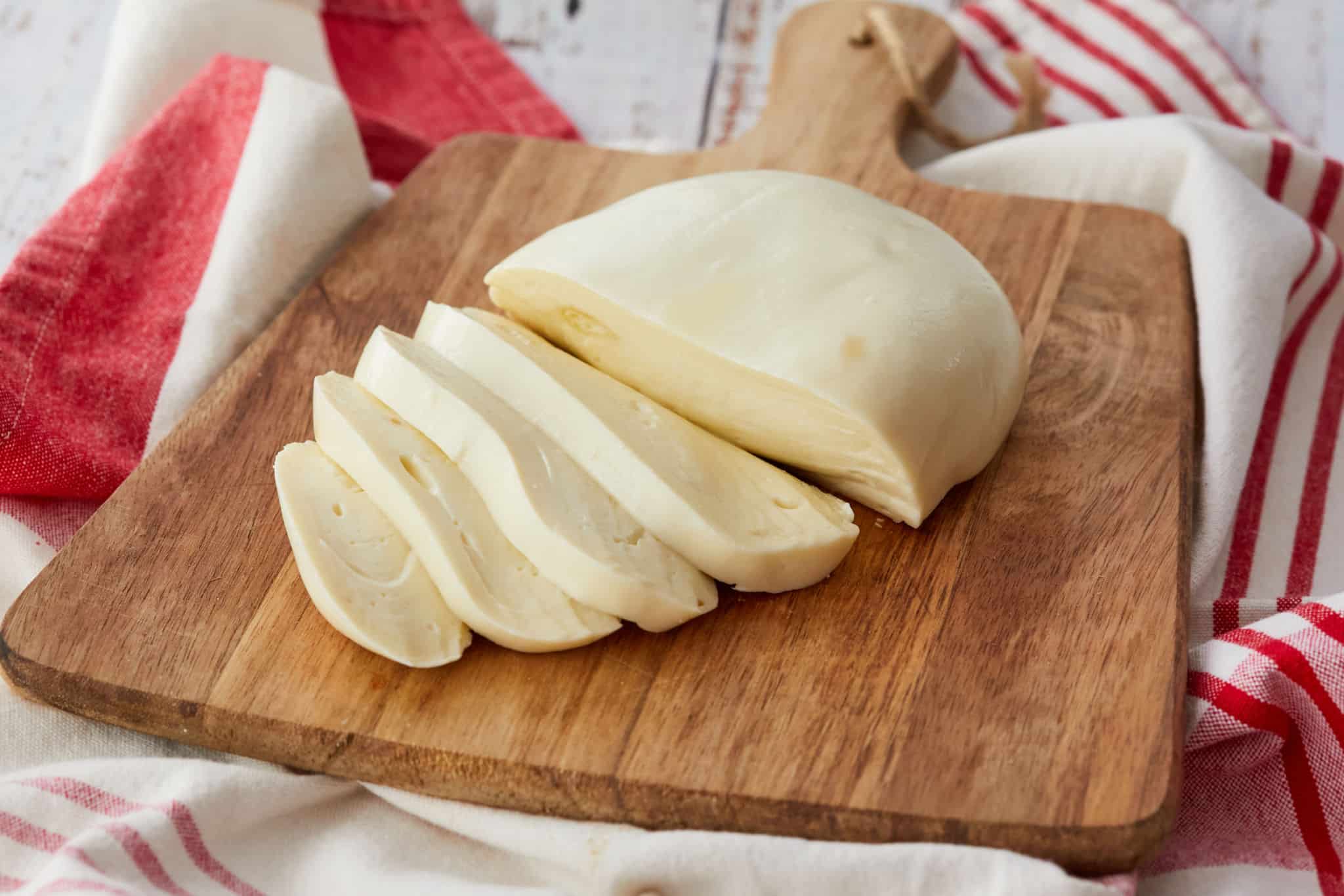
This post may contain affiliate links. Please see my full disclosure for details.
Hi Bold Bakers!
WHY YOU’LL LOVE THIS RECIPE: Learn how to make homemade mozzarella effortlessly with our straightforward recipe. Achieving authentic, restaurant-quality cheese has never been easier. Prepare to amaze your friends and family with mouthwatering, freshly made cheese straight from your kitchen, evoking an Italian bistro’s flavors!
- Ease of Preparation: Making mozzarella at home is simpler than you might think. Our recipe breaks down the process into easy steps, perfect for beginners and experienced cooks.
- Freshness Guaranteed: Our recipe ensures you experience the unmatched freshness of homemade cheese.
- Versatility: Homemade mozzarella can be used in countless ways from appetizers to entrées to let your culinary creativity shine.
- Quality Ingredients: With JUST 5 high-quality basic ingredients, you can achieve exceptional results.
- Expert Tips and Troubleshooting: Don’t worry if your mozzarella doesn’t turn out perfectly the first time. We provide a step-by-step tutorial video and expert troubleshooting advice to help you overcome any challenges and ensure success.
IMPORTANT NOTE: This recipe was improved and updated on 5/2/2024, to include NEW STEP-BY-STEP photography, a NEW STEP-BY-STEP tutorial VIDEO, and explanations of key ingredients.
Table of Contents
- What is Mozzarella Cheese?
- Tools You Need for Making Mozzarella Cheese
- Key Ingredients and Why
- How to Make Homemade Mozzarella Cheese?
- How to Store Homemade Mozzarella Cheese?
- FAQs
- Gemma’s Pro Chef Tips
- More Homemade Cheese Recipes
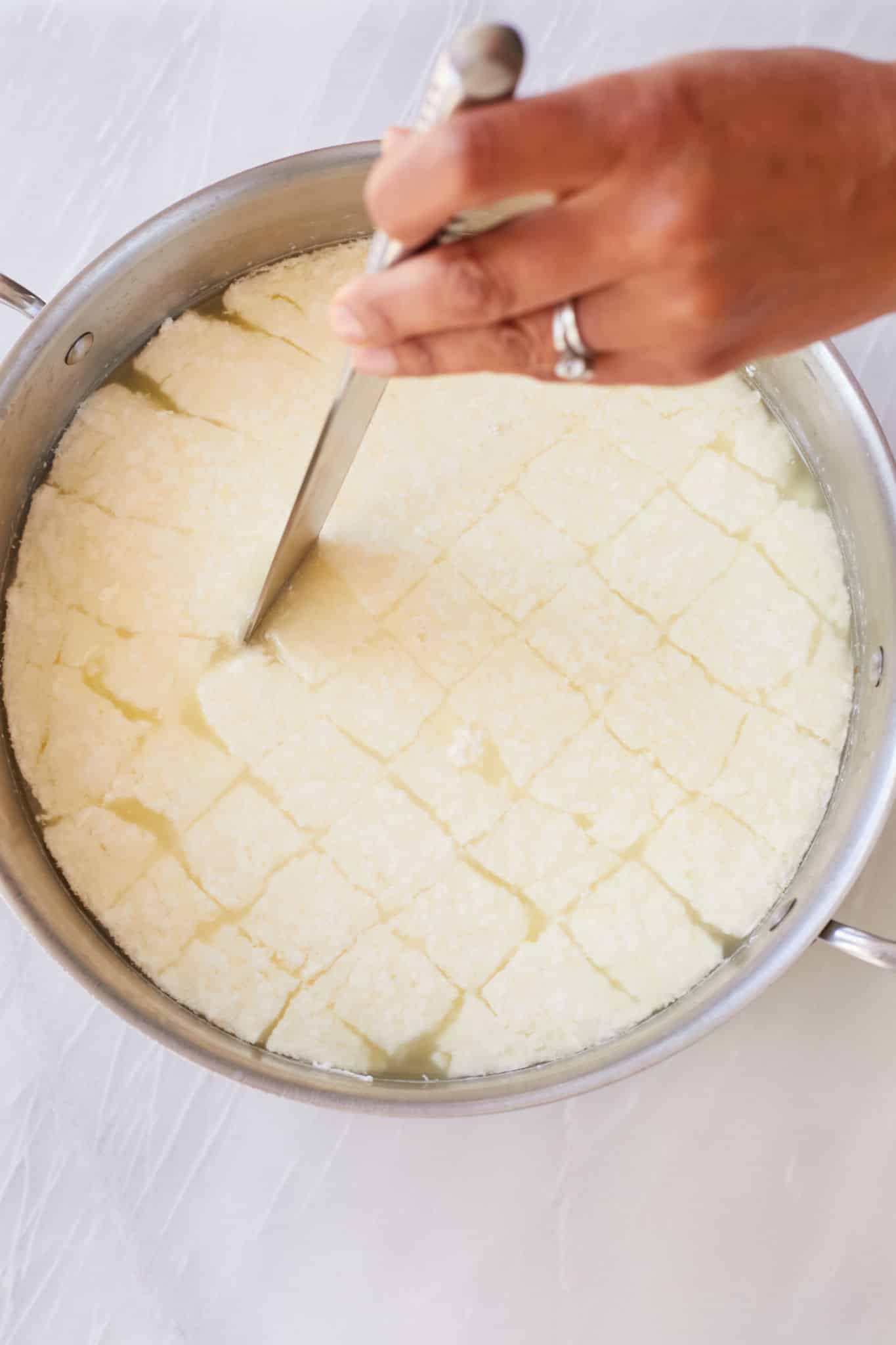
What is Mozzarella Cheese?
Mozzarella cheese is a fresh, semi-soft cheese that originated in Italy.
- It’s made from the milk of water buffaloes or cows and is known for its smooth texture, mild taste, and stretchy consistency when melted.
- Mozzarella is widely used in Italian cuisine, particularly in lasagna, or pizza dishes such as Pizza Cupcakes, Pepperoni Pizza Rolls, Microwave Mug Pizza, and Prosciutto Mozzarella Arugula Dutch Baby Recipe or Caprese Savory Tart. It’s also popular in many other cuisines around the world.
Tools You Need
- Measuring cups and measuring spoons
- Mixing bowls
- Large pot
- Cooking thermometer
- Fine Mesh Sieve or colander
- Cheesecloth
- Slotted spoon
- Kitchen gloves
Key Ingredients and Why
-
Citric acid
- Citric acid is used to acidify the milk, helping to lower its pH level. This acidity is essential for proper curd formation during the cheese-making process.
- It also contributes to the characteristic tangy flavor of mozzarella.
-
Water
Water is used in various stages of the cheese-making process.
-
- It is often used to dissolve citric acid and to dilute rennet before adding it to the milk.
- Water is also used for rinsing the cheese curds and in some cases for heating and kneading the cheese.
-
Liquid animal rennet
- Rennet is an enzyme that helps coagulate the milk, causing it to separate into curds and whey.
- In mozzarella making, liquid animal rennet is added to the milk to initiate the formation of curds. These curds will later be heated, stretched, and molded into mozzarella cheese.
-
Whole milk
Whole milk is the primary ingredient in fresh mozzarella cheese.
-
- The fat and proteins in the milk are essential for creating the creamy texture and rich flavor of the cheese.
- It’s important to use raw milk or pasteurized milk, as ultra-pasteurized milk has been heated to high temperatures, which can affect its ability to form proper curds.
-
Salt
- Salt is added to the cheese curds to enhance flavor and help preserve the cheese.
- It also plays a role in controlling the moisture content of the cheese and influencing its texture.
- Additionally, salt can help extract excess whey from the curds during the stretching process, resulting in a firmer cheese.
How to Make Homemade Mozzarella Cheese Recipe?
Preparation and mixing for making mozzarella cheese
- In a small bowl, combine the citric acid with ¼ cup (2 fl oz/60 ml) water and stir until combined. Set aside.
- In another small bowl, combine the rennet with the remaining ¼ cup (2 fl oz/60 ml) water. Stir until combined, then set aside.
- In a large pot, pour 1 gallon of milk and combine it with the citric acid mixture, and stir for 30 seconds until completely mixed.
- Turn on the meat to medium-low and using a thermometerstir the milk frequently, heat to 90°F (32°C). This should take about 5 minutes.
- Remove from the heat and stir in the rennet mixture for a full 30 seconds. Be sure to stir the milk from the bottom to the top so that it is completely and evenly mixed in.
- Remove the thermometer, place on a lid on the pot and don’t disturb it for 5 minutes.
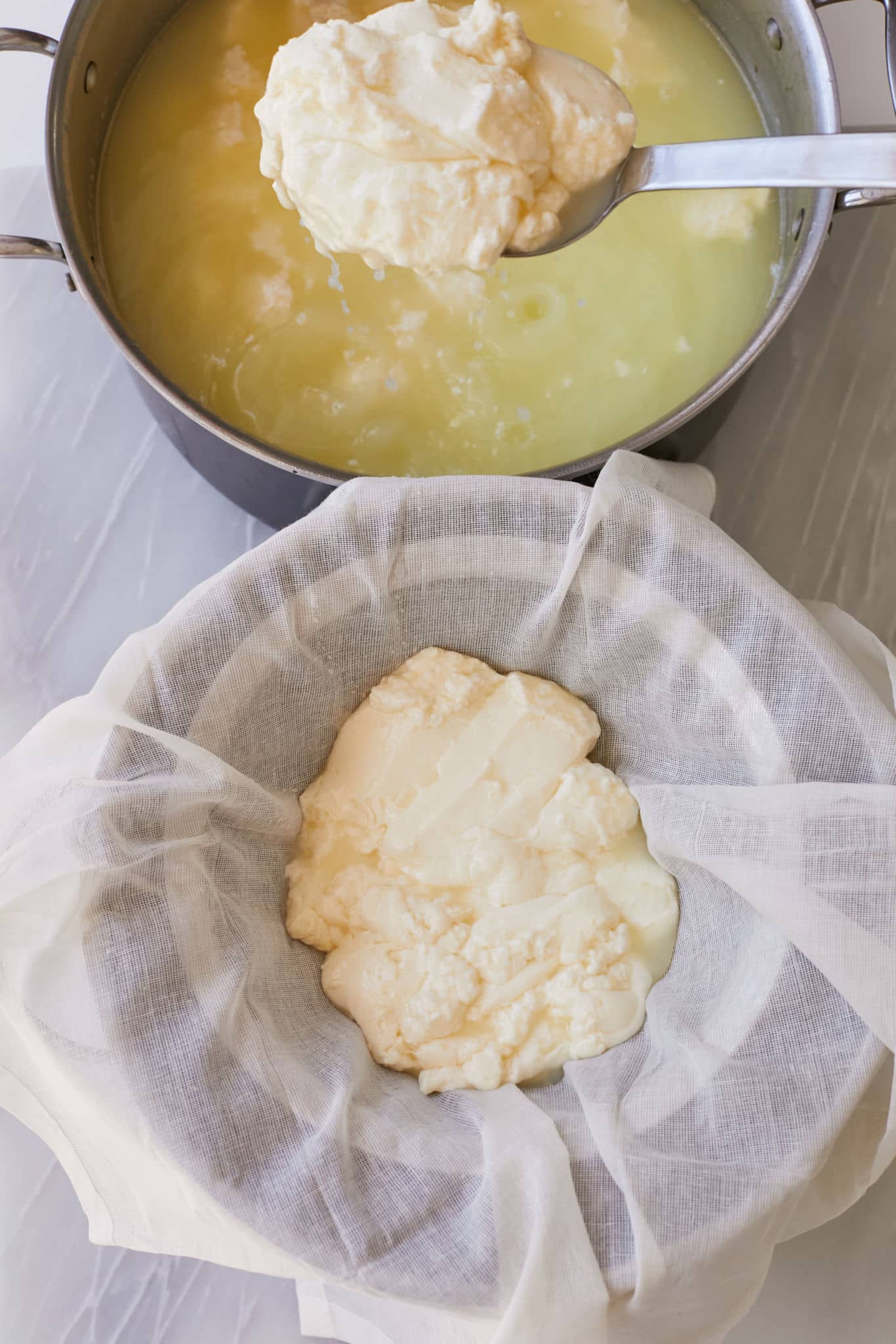
Curd formation and cutting in making mozzarella cheese
- Check to see if the curd has formed by slipping a knife between the milk and the side of the pot. If it comes away slightly, move on to the next step. If not, leave for another 5 minutes.
- Using a large knife, cut the curd all the way to the bottom of the pot in roughly 1-inch (2½-cm) strips. Then cut in the opposite direction to make a grid pattern.
- Return the pot to the stove and warm over low heat to 105°F (40°C) for about 5 minutes. Gently agitate the liquid without breaking up the curd to ensure even heating.
- Once again, remove the pot from the heat, place back on the lid and let it stand for 10 minutes.
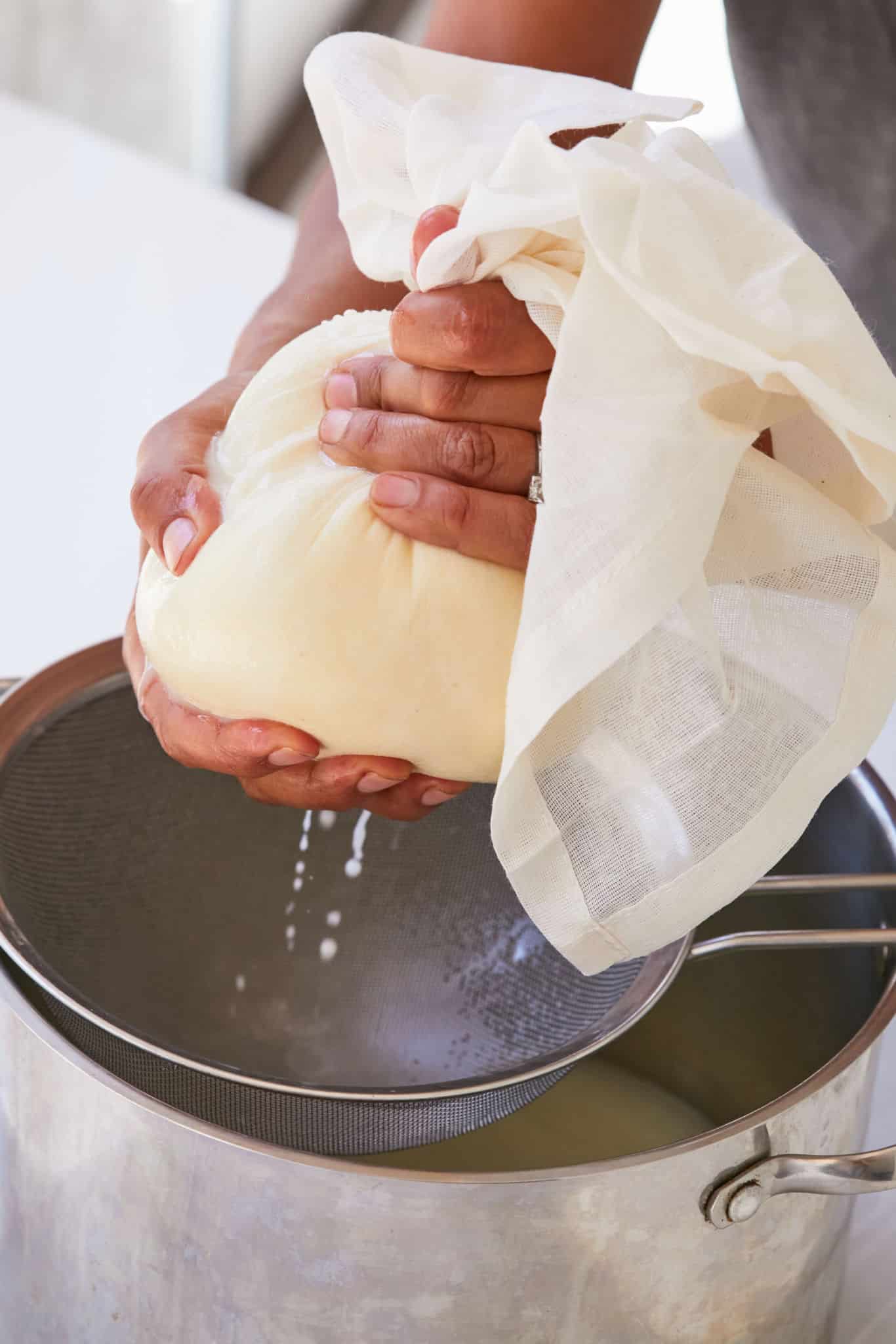
Curd draining and whey removal in making mozzarella cheese
- Place a fine-mesh sieve over a bowl and line the sieve with cheesecloth.
- Using a slotted spoon, lift the curd out of the pot and place it on the cheesecloth to drain.
- Put on clean kitchen gloves and firmly press on the curds to squeeze out as much whey as possible, using the cheesecloth to help squeeze.
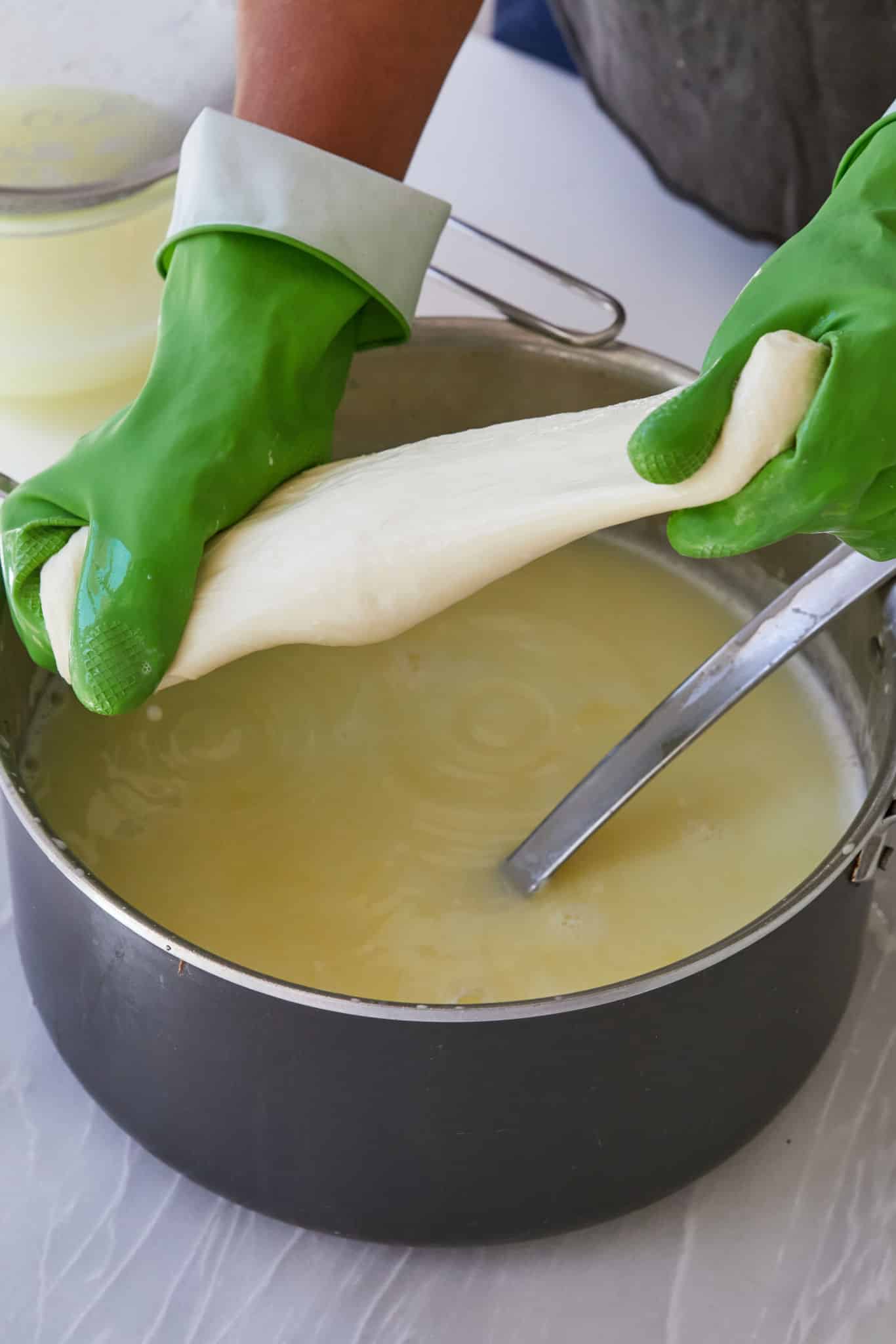
Curd stretching and folding in making mozzarella cheese
- Stir 3 teaspoons of salt into the liquid (whey) in the pot, then remove 4 cups (32 fl oz/260 ml) of whey to a medium bowl. Heat the remaining whey to 175° F (80°C) then turn off the heat.
- Place the curd into the hot whey for about 10 seconds. Remove with a slotted ladle, and then stretch and fold the curd a few times using gloves to protect your hands from the heat.
- Return the curd to the whey for another 10 seconds, then remove, and this time, stretch the curd and sprinkle on the remaining teaspoon of salt. Fold and stretch a few times, then return to the whey when it cools down.
- Continue this process 2 or 3 more times until the curds start to look like smooth, silky, shiny mozzarella.
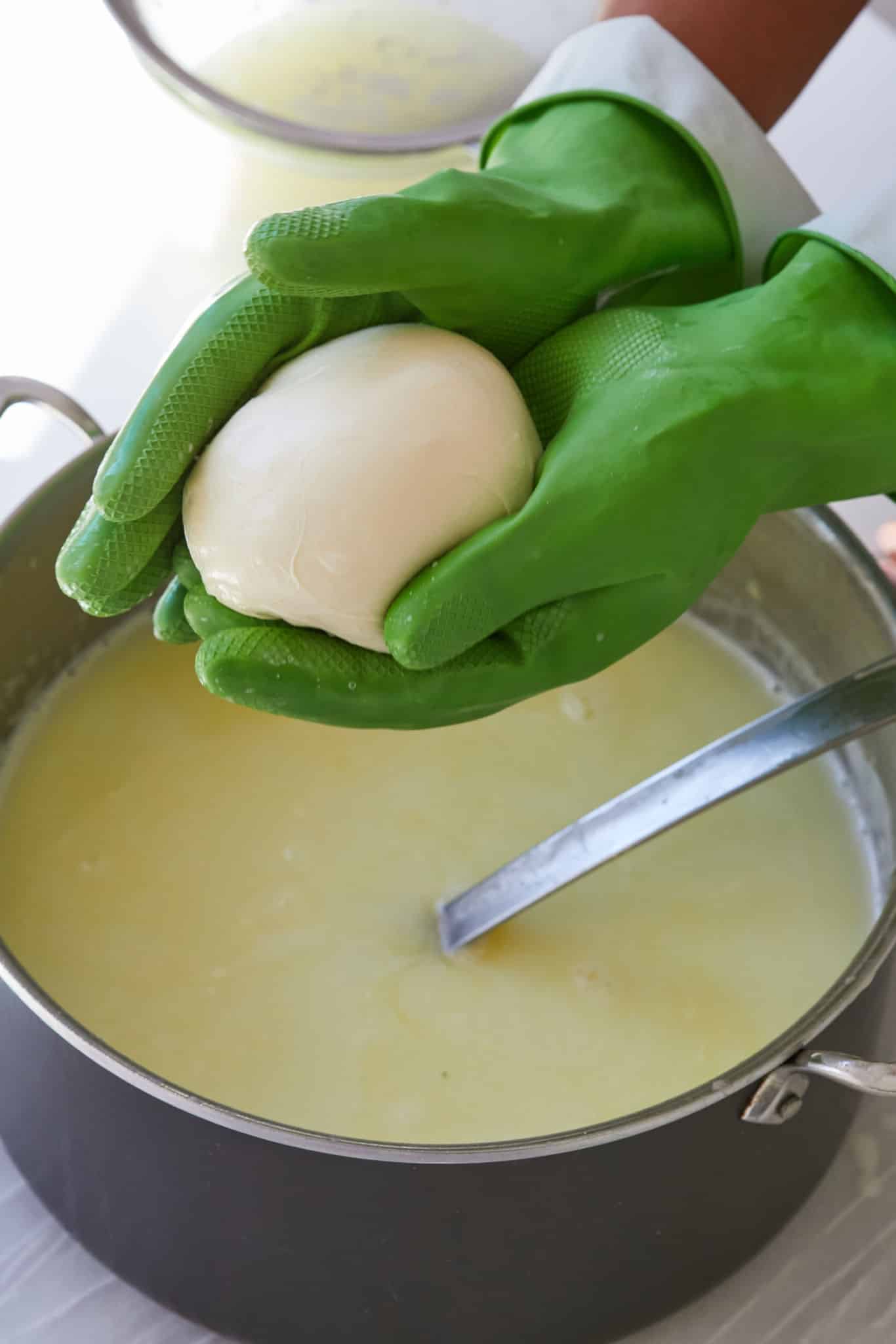
Shaping and setting the mozzarella cheese
- When you are done, create a smooth ball, tucking the edges underneath.
- Place this mozzarella ball into the hot water to seal the shape, then place it in the reserved cool whey to let it set for 15 minutes.
- Serve immediately.
How to Store Homemade Mozzarella Cheese?
- To enjoy the freshness of your Homemade Mozzarella, I highly recommend serving or using it immediately.
- If you want to enjoy your mozzarella at a later time, you can refrigerate it in an airtight container immersed in cold water for a week, but you will lose a bit of the quality. Keeping your mozzarella floating in liquid retains shape and moisture.
- Though you can refrigerate your fresh Homemade Mozzarella, I would avoid freezing it. This is because the high water content has a high chance of forming ice crystals. The cheese will no longer have the soft and smooth texture and will turn very dry and crumbly.
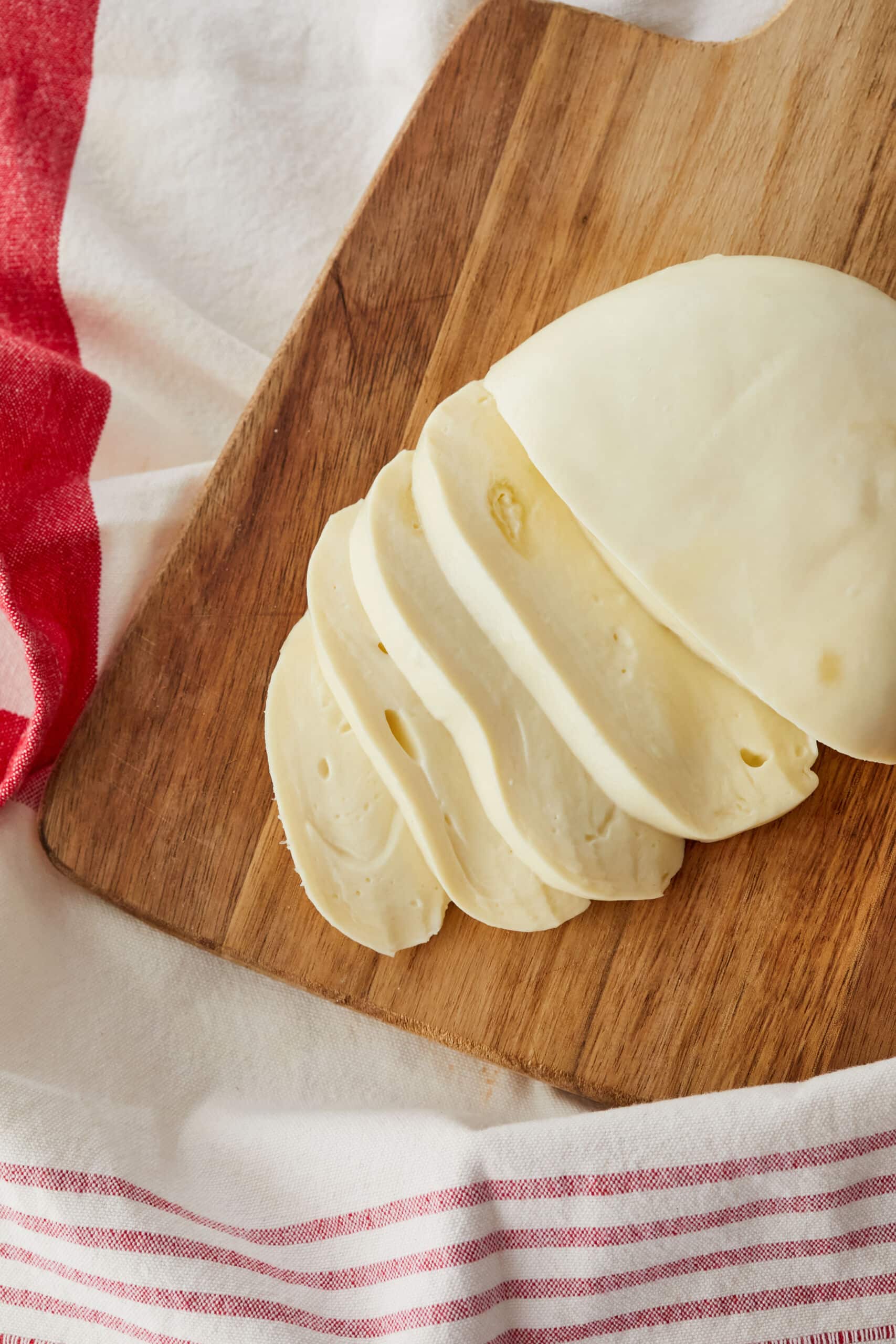
FAQs
Which milk should I use to make homemade mozzarella?
- I recommend using raw or pasteurized whole milk to make Homemade Mozzarella.
- Make sure that the milk you use is not ultra-pasteurized. This is because ultra-pasteurized milk has been heated at high temperatures, denaturing the proteins in the milk. With less protein, your milk won’t be able to form proper curds.
What is animal rennet and whey in cheese making?
- Animal rennet is an enzyme that comes from the stomach of an unweaned calf. Rennet is available in liquid form, which we use in this recipe. It’s a key ingredient when making cheese because it stimulates the isolation of cheese curds from liquid whey. You can sometimes find rennet at health food stores, but you can just as easily order it online!
- Whey is a clear, yellowish liquid byproduct of squeezing cheese curds. Don’t throw away your whey! Since liquid whey is packed with proteins, it’s important you use your whey to help thicken your homemade cheese during the heating and cooling process.
Why won’t my mozzarella curdle?
There are several reasons why your mozzarella won’t curdle.
- You may not have incorporated enough salt into your cheese curd, or you didn’t squeeze enough of the whey out.
- To troubleshoot this issue, try adding a bit more salt to your curd and squeeze your mozzarella thoroughly with cheesecloth.
Why isn’t my mozzarella stretching?
Mozzarella can be fussy to work with in the beginning.
- To make sure that your mozzarella stretches properly, pay attention to the temperatures and acidity levels.
- Don’t apply too much heat to your mozzarella. Keep the temperature at medium heat or a bit lower, depending on your stove. Additionally, make sure to let your whey and citric acid incorporate well into your curd. Mozzarella gains a lot of its elasticity and acidity from the whey and citric acid, so make sure you keep this in mind to get the perfect stretchy mozzarella!
- If you feel like your mozzarella is not stretching as much as you would like, heat your mozzarella some more.
Can you eat mozzarella raw?
- You can definitely eat mozzarella raw. Mozzarella has a tremendously soft and bouncy texture when eaten raw. Because of its fresh flavor profile, it goes well with various fruits and vegetables.
- In fact, mozzarella is relatively low in fat and calories compared to other types of cheeses. Fresh mozzarella is packed with biotin (Vitamin B7), potassium, zinc, and Riboflavin (Vitamin B2). It’s a healthier alternative to many other kinds of cheese — but everything in moderation!
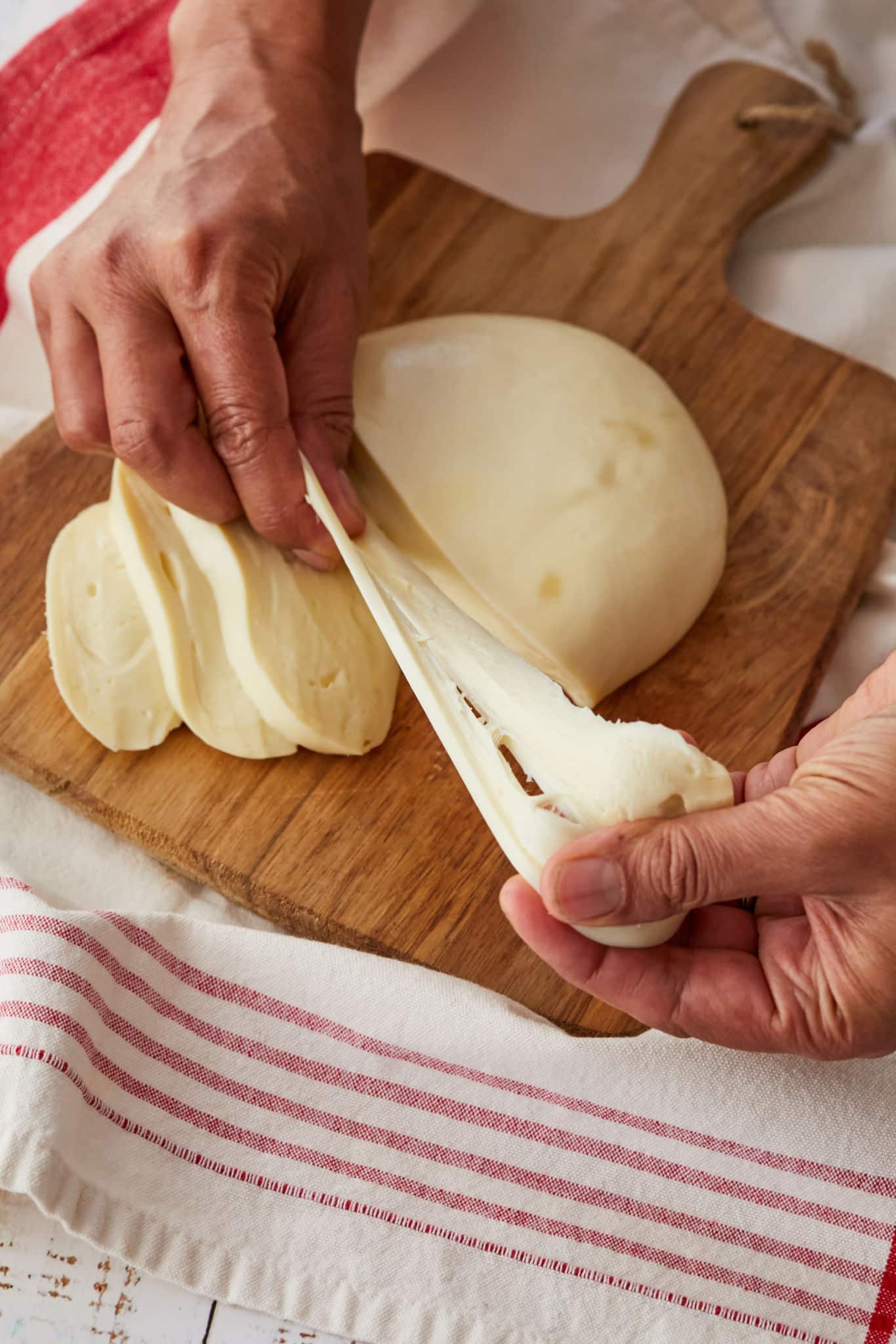
Gemma’s Pro Chef Tips For Making The Best Homemade Mozzarella
- In my experience, liquid animal rennet works the best. If you use Junket brand rennet tablets, you will need 2 whole tablets to form a proper curd (regardless of what the instructions say).
- Don’t attempt to make mozzarella without rennet. You need it to make a proper curd.
- A thermometer, cheesecloth, and clean kitchen rubber gloves are essential for making this recipe.
- Pay careful attention to all of the different temperatures. It may feel fussy at first, but once you try this recipe, you will find that it isn’t as complicated as it seems.
- Is your mozzarella dry and crumbly? You may have stretched it too much. Don’t overstretch your mozzarella curd. Otherwise, it will break the smooth structure of your curd and make your mozzarella very hard and rubbery.
More Homemade Cheese Recipes
- How to Make Cream Cheese
- How to Make Ricotta Cheese
- How to Make the Creamiest Mascarpone Cheese
- How to Make Vegan Cheese
IMPORTANT NOTE: This recipe was improved and updated on 5/2/2024, to include NEW STEP-BY-STEP photography, a NEW STEP-BY-STEP tutorial VIDEO, and explanations of key ingredients.
Watch The Recipe Video!
Homemade Mozzarella
Ingredients
- 1 ½ teaspoons citric acid
- ¼ cup (2 fl oz/60 ml) plus ¼ cup (2 fl oz/60 ml) water
- ¼ teaspoon liquid animal rennet
- 1 gallon raw or pasteurized (but not ultra-pasteurized) whole milk
- 4 teaspoons salt, divided
Instructions
Step 1
- In a small bowl, combine the citric acid with ¼ cup (2 fl oz/60 ml) water and stir until combined. Set aside.
- In another small bowl, combine the rennet with the remaining ¼ cup (2 fl oz/60 ml) water. Stir until combined, then set aside.
- In a large pot, combine the milk and citric acid mixture and stir for 30 seconds until completely mixed.
- Turn on the meat to medium-low and using a thermometer stir the milk frequently, heat to 90°F (32°C). This should take about 5 minutes.
- Remove from the heat and stir in the rennet mixture for a full 30 seconds. Be sure to stir the milk from the bottom to the top so that it is completely and evenly mixed in.
- Remove the thermometer, place on a lid on the pot and don’t disturb it for 5 minutes.
Step 2
- Check to see if the curd has formed by slipping a knife between the milk and the side of the pot. If it comes away slightly, move on to the next step. If not, leave for another 5 minutes.
- Using a large knife, cut the curd all the way to the bottom in roughly 1-inch (2½-cm) strips. Then cut in the opposite direction to make a grid pattern.
- Return the pot to the stove and warm over low heat to 105°F (40°C) for about 5 minutes. Gently agitate the liquid without breaking up the curd to ensure even heating.
- Once again, remove the pot from the heat, place back on the lid and let it stand for 10 minutes.
Step 3
- Place a fine-mesh sieve over a bowl and line the sieve with cheesecloth.
- Using a slotted spoon, lift the curd out of the pot and place it on the cheesecloth to drain.
- Put on clean kitchen gloves and firmly press on the curds to squeeze out as much whey as possible, using the cheesecloth to help squeeze.
Step 4
- Stir 3 teaspoons of salt into the liquid (whey) in the pot, then remove 4 cups (32 fl oz/260 ml) of whey to a medium bowl. Heat the remaining whey to 175° F (80°C) then turn off the heat.
- Place the curd into the hot whey for about 10 seconds. Remove with a slotted spoon, and then stretch and fold the curd a few times using gloves to protect your hands from the heat.
- Return the curd to the whey for another 10 seconds, then remove, and this time, stretch the curd and sprinkle on the remaining teaspoon of salt. Fold and stretch a few times, then return to the whey when it cools down.
- Continue this process 2 or 3 more times until the curds start to look like smooth, silky, shiny mozzarella.
Finishing the Mozzarella
- When you are done, create a smooth ball, tucking the edges underneath. Place this mozzarella ball into the hot water to seal the shape, then place it in the reserved cool whey to let it set for 15 minutes. Serve immediately or keep in the liquid in the fridge for a week.
Recipe Notes
- In my experience, liquid animal rennet works the best. If you use Junket brand rennet tablets, you will need 2 whole tablets to form a proper curd (regardless of what the instructions say).
- Don’t attempt to make mozzarella without rennet. You need it to make a proper curd.
- A thermometer, cheesecloth, and clean kitchen rubber gloves are essential for making this recipe.
- Pay careful attention to all of the different temperatures. It may feel fussy at first, but once you try this recipe, you will find that it isn’t as complicated as it seems.
- Is your mozzarella dry and crumbly? You may have stretched it too much. Don’t overstretch your mozzarella curd. Otherwise, it will break the smooth structure of your curd and make your mozzarella very hard and rubbery.

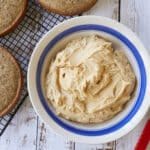
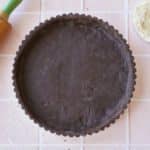
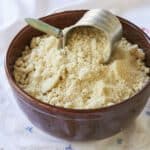



i truly appreciate all of the pics but I’d absolutely love a video. I’m going to try this on Friday, that’s pizza night around here!
Can you provide links for the animal rennet, citric acid, and kitchen gloves you’d recommend?
I want to try this recipe!
What is 1 gallon of milk in litres, I live in Canada
Hi Gemma – I routinely make paneer cheese and ricotta, and look forward to trying this recipe. Can you tell me how much mozerella you get from the gallon of milk? Thank you!
I love all the recipes from you that I e made which is a lot. Thank you so much. Tomorrow I plan to make this recipe. I have rennet in pill form. That’s all I could find in my area. Do you know how I can use this in place of the liquid? Thank you.
This recipe didn’t work at all and I am not a beginner cheesemaker. It turned out crumbly and wouldn’t hold together so the entire gallon of milk was wasted. Really unfortunate.
Can you make ricotta with the left over whey and if yes, how please? Dad used to make mozzarella and ricottta but I was a child in single digits so don’t know how he did it and he’s no longer around to ask. Thanks
Hi Gemma! Me again, with the questions.
● Do you use regular table salt in this recipe?
● Did you get more than 1 ball of mozza from the recipe? It looked like there were still curds left in in whey.
● Wherever did you get that thermometer clip? I’ve been unable to locate one locally …being from a small city, my shopping options are limited.
Thanks ever so much!
Do you think this recipe would work with almond milk?